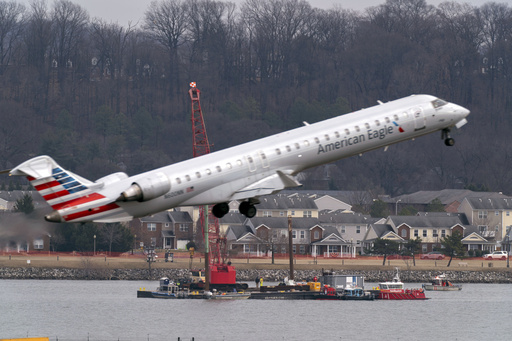
President Donald Trump attributed the tragic midair collision between a passenger plane and an Army helicopter last week to what he described as an outdated computer system utilized by U.S. air traffic controllers. Following the National Transportation Safety Board (NTSB) briefing to Congress that highlighted the helicopter’s advanced surveillance tech being disabled at the time of the incident, Trump has pledged to replace this system.
Trump remarked at an event that there were numerous errors that occurred on January 29, which led to the unfortunate crash involving an American Airlines flight originating from Wichita, Kansas, and an Army helicopter. This incident resulted in the loss of 67 lives onboard both aircraft as the plane prepared to land at Ronald Reagan National Airport near Washington, D.C.
Senator Ted Cruz, a Republican from Texas, shared that during a briefing, NTSB officials informed senators that the helicopter’s Automatic Dependent Surveillance-Broadcast (ADS-B) feature was deactivated. Cruz expressed frustration, stating, “The reason for turning it off does not seem justified,” especially since it was a training mission without any pressing national security reason for the ADS-B to be turned off. Additionally, it was noted that the helicopter crew might have been using night vision goggles at the time.
Initially, Trump suggested a link between diversity hiring initiatives and the collision. However, he directed his focus on the air traffic control computer system during a speech at the National Prayer Breakfast held at the U.S. Capitol. He criticized the U.S. government for investing billions in attempts to patch an outdated system instead of developing a modern one, revealing that he refuses to rely on the U.S. system in his private jet due to its obsolescence.
Trump indicated plans for a comprehensive overhaul of the computerized systems utilized in air traffic control towers. Furthermore, Transportation Secretary Sean Duffy and Elon Musk announced on social media that Musk’s team from the Department of Government Efficiency would assist in expediting improvements to the national aviation safety framework.
Since the mid-2000s, the Federal Aviation Administration (FAA) has been engaged in upgrading air traffic control systems through its NextGen initiative. Concerns about an overwhelmed and understaffed air traffic control network have been persistent over the years, particularly after multiple near-miss incidents at U.S. airports. Factors contributing to staffing shortages include inadequate salaries, taxing work schedules, rigorous training, and obligatory retirements.
Trump noted that a modern system potentially could have recognized the imminent danger when the Black Hawk helicopter, involved in a training exercise, and the passenger plane reached the same altitude. In contrast, an FAA report following the accident indicated that the controller had received an alert about the potential convergence of the two aircraft while they remained over a mile apart. The controller inquired whether the helicopter had visual contact with the plane, subsequently guiding it to navigate safely behind the passenger jet.
This week, the FAA reiterated its commitment to preventing helicopters and airplanes from sharing the same aerial space above the Potomac River in the future. Investigations currently center around establishing the precise altitudes of both aircraft at the time of impact. The flight recorder data revealed the passenger jet’s altitude to be approximately 325 feet, with an acceptable variance, while air traffic control system data suggested the helicopter may have been above its 200-foot flight ceiling.
To gather more detailed insights, investigators must now inspect the wreckage of the Black Hawk helicopter. As of Thursday afternoon, the U.S. Army Corps of Engineers reported that all significant components of both the helicopter and airplane have been removed from the river. Salvage teams plan to clear remaining debris in the upcoming days, aiming to complete their efforts by February 16.
Col. Francis Pera, the commander of the Baltimore District Corps, stated, “We will continue pushing forward in the coming days until we are confident the river is safe for navigation and that elements of evidentiary value are recovered and provided to the appropriate authorities.” This tragic accident marks the deadliest air collision in the U.S. since November 12, 2001, when an airline jet crashed into a New York City neighborhood shortly after takeoff, claiming the lives of all 260 people aboard and five individuals on the ground.
Concerns have arisen regarding the potential exacerbation of air traffic controller shortages resulting from Trump’s plans to reduce the federal workforce. In response, air traffic controllers were informed by their union that certain positions, including theirs within the FAA, would be exempt from the recent deferred resignation offers extended to federal employees. The National Air Traffic Controllers Association has advised its members to decline these offers to safeguard national security and public safety.

